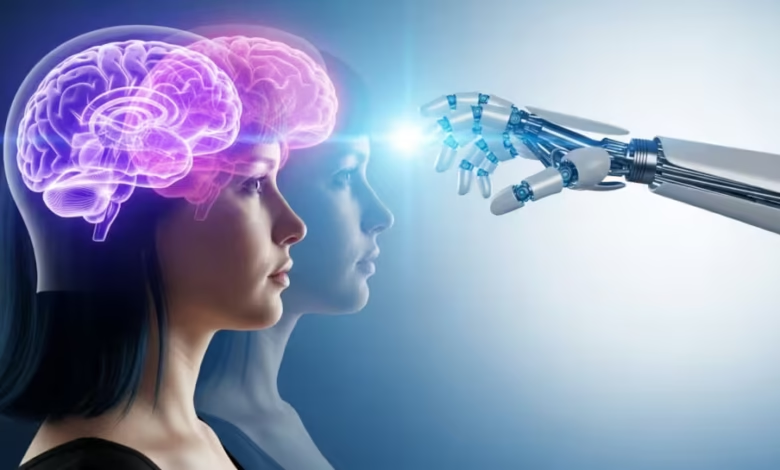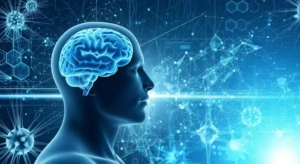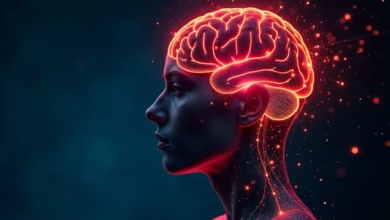AI and Mental Health: Can Algorithms Provide Emotional Support?

This blog post explores the intersection of AI and mental health, highlighting the potential for AI mental health support through innovative technologies. It examines how therapy bots and emotion AI are transforming the mental health landscape by offering personalized assistance and companionship to those in need. The article further discusses the rise of virtual counseling, emphasizing the opportunities it presents for increased access and affordability of mental health care. Lastly, readers are encouraged to take action by leveraging AI to improve their mental health support systems, suggesting that while algorithms cannot replace human connection, they can serve as valuable tools in the therapeutic process.
Exploring The Intersection Of AI And Mental Health

The integration of AI mental health support into therapeutic practices is revolutionizing how individuals approach mental well-being. Mental health apps equipped with sophisticated algorithms provide users with personalized assistance, helping them manage stress, anxiety, and other emotional challenges more effectively. These tools leverage vast amounts of data to resonate with users on a personal level, often making mental health support more accessible than traditional therapy sessions. As technology continues to advance, we can expect AI to offer innovative solutions that could potentially bridge the gap in mental health care, especially for those who may hesitate to seek help.
Key Aspects of AI Mental Health Support
- Personalization: Tailors strategies based on user data and preferences.
- Accessibility: Offers support anytime, anywhere, reducing barriers to care.
- Confidentiality: Provides a safe environment for users to express their feelings.
- Real-time feedback: Delivers immediate responses to users’ emotional inputs.
- Affordability: Often more cost-effective than traditional therapy options.
- Scalability: Can reach a larger audience, addressing the public health crisis of mental health.
With the increasing prominence of these mental health apps, it’s important to consider their implications and effectiveness. Researchers and practitioners are recognizing the potential of AI as not just a tool for diagnosis but also as a companion for emotional support. By continuously enhancing these platforms, developers aim to create more reliable systems that can contribute positively to mental health outcomes, fostering a future where mental wellness is prioritized and more easily attainable for everyone.
How Therapy Bots And Emotion AI Are Changing The Landscape

The integration of therapy bots and emotion AI into mental health practices signifies a transformative shift in how individuals access support. These advanced technologies leverage algorithms to provide immediate assistance, functioning around the clock to cater to individuals who may find it difficult to reach a traditional therapist. As the demand for mental health resources continues to rise, the ability of AI systems to personalize interactions enhances their effectiveness in delivering emotional support.
Moreover, these developments often yield cost-effective solutions that can minimize barriers to mental health care. Through the use of therapy bots, people can access resources without facing the stigma often associated with seeking help. This accessibility is pivotal in addressing the mental health crisis, making it easier for individuals in diverse backgrounds to engage in conversations about their feelings and thoughts. It also facilitates a safer environment where they can explore their mental health challenges without judgment.
| Technology | Functionality | Potential Impact |
|---|---|---|
| Therapy Bots | Provide conversational support | Enhance accessibility to immediate support |
| Emotion AI | Analyze emotional responses | Personalize user interactions |
| Data Analytics | Track user progress | Improve treatment recommendations |
Yet, the journey towards widespread adoption of therapy bots is not without its challenges. Concerns about user privacy and data security are at the forefront, as individuals must share sensitive information for these systems to be effective. Additionally, the inability of therapy bots to provide the nuanced understanding that a human therapist offers presents limitations in addressing complex emotional issues. Overcoming these hurdles is crucial in realizing the full potential of AI mental health support.
Benefits Of Therapy Bots
Despite the challenges, the benefits of therapy bots are substantial. They offer consistent support and the ability to reach users at any time of the day, which is particularly beneficial for those who may not be comfortable with face-to-face therapy. The anonymity and ease of access could encourage more people to seek help. Furthermore, therapy bots can assist individuals in managing their mental health proactively, providing tools and resources that foster resilience and self-awareness.
Steps To Implement Therapy Bots
- Identify specific target audiences and their unique needs.
- Choose a reliable therapist or consultant to guide the bot development.
- Use emotion AI to enhance the bot’s ability to interact empathetically.
- Conduct pilot tests to gather user feedback on functionality and experience.
- Ensure compliance with data protection laws and ethical guidelines.
- Launch the therapy bot with adequate support resources for users.
- Continuously refine the system based on user feedback and performance metrics.
As we progress in this evolving landscape, the incorporation of therapy bots and emotion AI holds great promise for revolutionizing mental health support systems. By understanding and leveraging these technologies, we can create a more responsive, compassionate mental health environment that meets the needs of individuals all around the globe.
The Rise Of Virtual Counseling And Its Opportunities

The landscape of mental health support has transformed significantly with the integration of technology. Virtual counseling has emerged as a viable alternative to traditional face-to-face therapy, offering individuals the convenience and accessibility they desire. With the advent of AI mental health support, these services have not only expanded reach but have also introduced innovative ways to engage with those in need. The possibilities are endless, as more people turn to digital solutions for their mental well-being.
Types Of Virtual Counseling Services
- Teletherapy: Live video sessions with licensed therapists.
- Message-based therapy: Communication through text or chat for on-demand support.
- Interactive apps: Programs that guide users through self-help activities.
- AI-powered bots: Tools offering automated responses and emotional support.
- Support groups: Online forums facilitating peer interaction and shared experiences.
- Mindfulness and wellness apps: Programs designed to promote mental well-being through exercises and feedback.
Moreover, advancements in technology, particularly in AI empathy, are redefining how mental health services can be delivered. By incorporating emotionally intelligent algorithms, virtual counseling platforms can understand and respond to user emotions, creating a more personalized and engaging experience. This is particularly important in fostering a sense of connection and support that individuals may crave when seeking help.
Examples Of Successful Mental Health Apps
Several applications highlight the potential of virtual counseling and AI-assisted support. For instance, apps like BetterHelp and Talkspace leverage licensed professionals for video or text therapy. Another notable example is Woebot, a chatbot designed to provide AI mental health support through conversational interactions. These platforms showcase how technology can bridge the gap in mental health services, allowing users to access care from the comfort of their homes.
Leveraging AI For Better Mental Health Support

As society continues to embrace technology, the integration of AI mental health support into therapeutic practices offers new avenues for individuals seeking assistance. This innovation aims to enhance traditional mental health services, making them more accessible and personalized. With the rise of mental health apps powered by artificial intelligence, users can receive tailored guidance and interventions based on their unique emotional states, fostering a deeper level of engagement with their mental health journey.
Next Steps To Utilize AI Tools
- Identify your specific mental health needs to choose the right AI tools.
- Research reputable mental health apps that utilize AI technology.
- Experiment with different apps to find the one that resonates best with you.
- Integrate these tools into your daily routine for consistent support.
- Monitor your progress using the analytics provided by the apps.
- Seek feedback from mental health professionals to enhance your AI experience.
- Stay informed about updates and improvements in AI mental health support.
By following these steps, individuals can effectively harness the power of AI in their mental health journeys. It’s crucial to remember that while AI mental health support is a valuable resource, it should complement, not replace, professional therapy. These tools can serve as an additional layer of support, reminding us that technology has a role in addressing emotional well-being.
Briefing Document: The Transformative Role of AI in Mental Health Support
I. Summary
This brief examines the growing intersection of AI and mental health and highlights how innovative technologies like therapy robots, emotional AI, and virtual counseling are fundamentally changing access to and delivery of mental health services. While recognizing AI’s tremendous potential to personalize support, increase accessibility, and reduce costs and stigma, the document also addresses critical challenges such as data privacy and AI’s limitations in emulating nuanced human understanding. The overall message is that AI serves as a valuable complement to the therapeutic process, rather than a replacement for human connection.
II. Main Themes and Key Ideas
A. AI is Revolutionizing Mental Health Support
The central premise is that “the integration of AI mental health support into therapeutic practices is revolutionizing how individuals approach mental well-being.” This revolution is driven by:
- Personalization: AI tools “tailor strategies based on user data and preferences,” allowing for more effective management of stress, anxiety, and other emotional challenges.
- Accessibility: AI offers “support anytime, anywhere, reducing barriers to care” and addressing the “public health crisis of mental health” by reaching a larger audience. This is particularly crucial for “those who may hesitate to seek help.”
- Affordability: AI-driven solutions are “often more cost-effective than traditional therapy options,” minimizing financial barriers to care.
- Confidentiality: AI platforms provide a “safe environment for users to express their feelings,” fostering a sense of security and anonymity.
- Real-time Feedback: These systems deliver “immediate responses to users’ emotional inputs,” offering prompt support.
B. Therapy Bots and Emotion AI are Transforming the Landscape
“The integration of therapy bots and emotion AI into mental health practices signifies a transformative shift.”
- Therapy Bots:Provide “conversational support” and “immediate assistance, functioning around the clock.”
- Enhance accessibility by offering “consistent support and the ability to reach users at any time of the day.”
- Minimize stigma, as “people can access resources without facing the stigma often associated with seeking help.”
- Examples include Woebot, a chatbot providing “conversational interactions.”
- Emotion AI:Is crucial for “analyz[ing] emotional responses” and “personaliz[ing] user interactions.”
- By incorporating “emotionally intelligent algorithms, virtual counseling platforms can understand and respond to user emotions, creating a more personalized and engaging experience.”
C. The Rise of Virtual Counseling and its Opportunities
Virtual counseling has become a “viable alternative to traditional face-to-face therapy,” offering convenience and expanding reach.
- Types of Virtual Counseling Services: The article lists various forms, including “Teletherapy (Live video sessions),” “Message-based therapy,” “Interactive apps,” “AI-powered bots,” “Support groups,” and “Mindfulness and wellness apps.”
- Enhanced by AI: AI advancements, particularly in “AI empathy,” are redefining service delivery by enabling platforms to understand and respond to user emotions, fostering a sense of connection.
- Successful Examples: Apps like “BetterHelp and Talkspace leverage licensed professionals for video or text therapy,” while Woebot demonstrates the power of AI chatbots.
D. Challenges and Limitations
Despite the significant benefits, the widespread adoption of AI in mental health faces hurdles:
- Privacy and Data Security: “Concerns about user privacy and data security are at the forefront, as individuals must share sensitive information for these systems to be effective.”
- Nuanced Understanding: A key limitation is “the inability of therapy bots to provide the nuanced understanding that a human therapist offers” in addressing complex emotional issues. Algorithms “cannot replace human connection.”
E. Leveraging AI: A Complementary Role
The document strongly advocates for AI as a complementary tool rather than a substitute for professional therapy.
- Strategic Utilization: Individuals are encouraged to “identify your specific mental health needs to choose the right AI tools” and “experiment with different apps to find the one that resonates best with you.”
- Integration into Routine: Users should “integrate these tools into your daily routine for consistent support.”
- Professional Guidance: It is vital to “seek feedback from mental health professionals to enhance your AI experience.”
- Supportive Layer: The article emphasizes that AI tools “should complement, not replace, professional therapy. These tools can serve as an additional layer of support.”
III. Important Facts and Quotes
- Date of Article: 30/06/2025
- Core Assertion: “AI and Mental Health: Can Algorithms Provide Emotional Support?”
- Accessibility and Affordability: AI “often making mental health support more accessible than traditional therapy sessions” and is “more cost-effective.”
- Addressing the Crisis: AI “could potentially bridge the gap in mental health care, especially for those who may hesitate to seek help.”
- Therapy Bot Benefits: They offer “consistent support and the ability to reach users at any time of the day, which is particularly beneficial for those who may not be comfortable with face-to-face therapy.”
- Data Concerns: “Concerns about user privacy and data security are at the forefront.”
- AI’s Role (Direct Quote): “while algorithms cannot replace human connection, they can serve as valuable tools in the therapeutic process.”
- Call to Action: “leveraging AI to improve their mental health support systems.”
AI is poised to significantly reshape the mental health landscape by enhancing personalization, accessibility, and affordability of care. Therapy bots and emotion AI are at the forefront of this transformation, offering immediate and confidential support. However, it is crucial to address challenges related to data privacy and the inherent limitations of AI in replicating human empathy and nuanced understanding. Ultimately, AI in mental health is best viewed as a powerful complementary resource, working in conjunction with, rather than replacing, the invaluable role of human therapists and genuine human connection.
For similar articles, please visit: AI and Human Mind & Psychology
Homepage / humanaifuture.com
🎧 Listen to the Podcast
Want to explore this topic in more depth? Listen to the full podcast for more insights and expert commentary.
▶️ Play on Google DriveNo sign-up needed — just click and listen.
What are "therapy bots" and "emotion AI," and how do they function?
Therapy bots are AI systems designed to provide conversational emotional support, functioning around the clock to offer immediate assistance. Emotion AI analyzes emotional responses and helps personalize user interactions by understanding and responding to their feelings. Together, they enhance the accessibility and personalization of mental health care, making it easier for individuals to engage in conversations about their mental well-being without the immediate need for a human therapist.
What are the key benefits of using AI for mental health support?
The benefits of AI in mental health support include enhanced accessibility (anytime, anywhere access), increased affordability compared to traditional therapy, strong confidentiality, and personalization of support strategies based on individual needs. AI tools like therapy bots can offer consistent support, proactive mental health management, and reduce the stigma often associated with seeking help, encouraging more people to engage with mental health resources.
What are the challenges and limitations of AI in mental health?
Despite the significant benefits, challenges remain, particularly concerning user privacy and data security, as sensitive information must be shared for these systems to be effective. A major limitation is the inability of AI to provide the nuanced understanding and empathetic connection that a human therapist offers, especially when addressing complex emotional issues. Overcoming these hurdles is crucial for the widespread adoption and effectiveness of AI mental health support.
How does virtual counseling leverage AI and what types of services are available?
Virtual counseling utilizes AI to expand its reach and innovate how mental health services are delivered. AI empathy, for instance, allows platforms to understand and respond to user emotions, fostering a sense of connection. Types of virtual counseling services include teletherapy (live video sessions), message-based therapy, interactive self-help apps, AI-powered bots for automated support, online support groups, and mindfulness/wellness apps designed to promote mental well-being.
Can AI completely replace human therapists?
No, AI cannot completely replace human therapists. While AI mental health support offers valuable resources like accessibility, personalization, and real-time feedback, it is designed to complement, not substitute, professional human therapy. AI tools serve as an additional layer of support, providing assistance and guidance, but they lack the nuanced understanding, complex emotional intelligence, and human connection that a licensed therapist provides for deep-seated or complex emotional issues.
How can individuals effectively use AI tools for their mental health journey?
To effectively utilize AI tools for mental health, individuals should first identify their specific needs to choose appropriate tools. It's recommended to research reputable mental health apps that use AI, experiment with different options to find the best fit, and integrate these tools into a daily routine for consistent support. Monitoring progress through app analytics and seeking feedback from mental health professionals can further enhance the AI experience, while staying informed about updates is also beneficial.
What are some examples of successful mental health apps incorporating AI?
Successful mental health applications that highlight the potential of virtual counseling and AI-assisted support include platforms like BetterHelp and Talkspace, which connect users with licensed professionals for video or text-based therapy. Another notable example is Woebot, a chatbot specifically designed to provide AI mental health support through conversational interactions. These platforms demonstrate how technology can bridge gaps in mental health services, offering accessible care from home.




